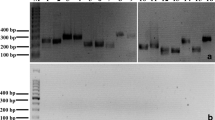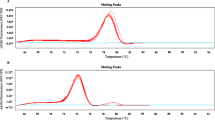Abstract
Waterborne diseases due to pathogen contamination in water are a serious problem all over the world. Accurate and simultaneous detection of pathogens in water is important to protect public health. In this study, we developed a method to simultaneously detect various pathogenic Escherichia coli by sequencing the amplicons of multiplex PCR. Our newly designed multiplex PCR amplified five genes for pathogenic E. coli (uidA, stx1, stx2, STh gene, and LT gene). Additional two PCR assays (for aggR and eae) were also designed and included in the amplicon sequencing analysis. The same assays were also used for digital PCR (dPCR). Strong positive correlations were observed between the sequence read count and the dPCR results for most of the genes targeted, suggesting that our multiplex PCR-amplicon sequencing approach could provide quantitative information. The method was also successfully applied to monitor the level of pathogenic E. coli in river water and wastewater samples. The approach shown here could be expanded by targeting genes for other pathogens.




Similar content being viewed by others
Data availability
All data generated or analyzed during this study are included in this published article [and its supplementary information files].
References
Ahmed, W., Gyawali, P., & Toze, S. (2015). Quantitative PCR measurements of Escherichia coli including shiga toxin-producing E. coli (STEC) in animal feces and environmental waters. Environmental Science Technology, 49(5), 3084–3090. https://doi.org/10.1021/es505477n
Ahmed, W., Zhang, Q., Lobos, A., Senkbeil, J., Sadowsky, M. J., Harwood, V. J., Saeidi, N., Marinoni, O., & Ishii, S. (2018). Precipitation influences pathogenic bacteria and antibiotic resistance gene abundance in storm drain outfalls in coastal sub-tropical waters. Environment International, 116, 308–318. https://doi.org/10.1016/j.envint.2018.04.005
Boisen, N., Melton-Celsa, A. R., Scheutz, F., O’Brien, A. D., & Nataro, J. P. (2015). Shiga toxin 2a and enteroaggregative Escherichia coli – a deadly combination. Gut Microbes, 6, 272–278. https://doi.org/10.1080/19490976.2015.1054591
Bradshaw, J. K., Snyder, B. J., Oladeinde, A., Spidle, D., Berrang, M. E., Meinersmann, R. J., Oakley, B., Sidle, R. C., Sullivan, K., & Molina, M. (2016). Characterizing relationships among fecal indicator bacteria, microbial source tracking markers, and associated waterborne pathogen occurrence in stream water and sediments in a mixed land use watershed. Water Research, 101, 498–509. https://doi.org/10.1016/j.watres.2016.05.014
Canizalez-Roman, A., Velazquez-Roman, J., Valdez-Flores, M. A., Flores-Villaseñor, H., Vidal, J. E., Muro-Amador, S., Guadrón-Llanos, A. M., Gonzalez-Nuñez, E., Medina-Serrano, J., Tapia-Pastrana, G., & León-Sicairos, N. (2019). Detection of antimicrobial-resistance diarrheagenic Escherichia coli strains in surface water used to irrigate food products in the northwest of Mexico. International Journal of Food Microbiology, 304, 1–10. https://doi.org/10.1016/j.ijfoodmicro.2019.05.017
Cheng, X., Xu, J., Smith, G., Nirmalakhandan, N., & Zhang, Y. (2021). Metagenomic profiling of antibiotic resistance and virulence removal: Activated sludge vs. algal wastewater treatment system. Journal of Environmental Management, 295, 113129. https://doi.org/10.1016/j.jenvman.2021.113129
Cui, Q., Huang, Y., Wang, H., & Fang, T. (2019). Diversity and abundance of bacterial pathogens in urban rivers impacted by domestic sewage. Environmental Pollution, 249, 24–35. https://doi.org/10.1016/j.envpol.2019.02.094
Duris, J. W., Reif, A. G., Krouse, D. K., & Issacs, N. M. (2013). Factors related to occurrence and distribution of selected bacterial and protozoan pathogens in Pennsylvania streams. Water Research, 47, 300–314. https://doi.org/10.1016/j.watres.2012.10.006
Farajzadeh-Sheikh, A., Savari, M., & Afzali, M. (2020). Distribution of genes encoding virulence factors and the genetic diversity of enteroinvasive Escherichia coli (EIEC) isolates from patients with diarrhea in Ahvaz, Iran. Infection and Drug Resistance, 13, 119–127. https://doi.org/10.2147/IDR.S235009
Goh, S. G., Saeidi, N., Gu, X., Vergara, G. G. R., Liang, L., Fang, H., Kitajima, M., Kushmaro, A., & Gin, K. Y. H. (2019). Occurrence of microbial indicators, pathogenic bacteria and viruses in tropical surface waters subject to contrasting land use. Water Research, 150, 200–215. https://doi.org/10.1016/j.watres.2018.11.058
Harismendy, O., Ng, P. C., Strausberg, R. L., Wang, X., Stockwell, T. B., Beeson, K. Y., Schork, N. J., Murray, S. S., Topol, E. J., Levy, S., & Frazer, K. A. (2009). Evaluation of next generation sequencing platforms for population targeted sequencing studies. Genome Biology, 10(3), R32. https://doi.org/10.1186/gb-2009-10-3-r32
Hsu, B. M., Wu, S. F., Huang, S. W., Tseng, Y. J., Ji, D. D., Chen, J. S., & Shih, F. C. (2010). Differentiation and identification of Shigella spp. and enteroinvasive Escherichia coli in environmental waters by a molecular method and biochemical test. Water Research, 44(3), 949–955. https://doi.org/10.1016/j.watres.2009.10.004
Huang, W., Hsu, M., Su, J., Ji, D., Lin, C., Chen, L., Shih, C., Kao, M., & Chiu, C. (2012). Occurrence of diarrheagenic Escherichia coli genes in raw water of water treatment plants. Environmental Science and Pollution Research, 19, 2776–2783. https://doi.org/10.1007/s11356-012-0777-4
Huang, W. C., Hsu, B. M., Kao, P. M., Tao, C. W., Ho, Y. N., Kuo, C. W., & Huang, Y. L. (2016). Seasonal distribution and prevalence of diarrheagenic Escherichia coli in different aquatic environments in Taiwan. Ecotoxicology and Environmental Safety, 124, 37–41. https://doi.org/10.1016/j.ecoenv.2015.09.040
Ishii, S. (2020). Quantification of antibiotic resistance genes for environmental monitoring: Current methods and future directions. Current Opinion Environmental Science & Health, 16, 47–53. https://doi.org/10.1016/j.coesh.2020.02.004
Ishii, S., Nakamura, T., Ozawa, S., Kobayashi, A., Sano, D., & Okabe, S. (2014). Water quality monitoring and risk assessment by simultaneous multipathogen quantification. Environmental Science and Technology, 48(9), 4744–4749. https://doi.org/10.1021/es500578s
Ishii, S., Segawa, T., & Okabe, S. (2013). Simultaneous quantification of multiple food- and waterborne pathogens by use of microfluidic quantitative PCR. Applied and Environment Microbiology, 79, 2891–2898. https://doi.org/10.1128/AEM.00205-13
Jikumaru, A., Ishii, S., Fukudome, T., Kawahara, Y., Iguchi, A., Masago, Y., Nukazawa, K., & Suzuki, Y. (2020). Fast, sensitive, and reliable detection of waterborne pathogens by digital PCR after coagulation and foam concentration. Journal of Bioscience and Bioengineering, 130, 76–81. https://doi.org/10.1016/j.jbiosc.2020.02.004
Kobayashi, M., Zhang, Q., Segawa, T., Maeda, M., Hirano, R., Okabe, S., & Ishii, S. (2022). Temporal dynamics of Campylobacter and Arcobacter in a freshwater lake that receives fecal inputs from migratory geese. Water Research, 217, 118397. https://doi.org/10.1016/j.watres.2022.118397
Kong, R. Y. C., So, C. L., Law, W. F., & Wu, R. S. S. (1999). A sensitive and versatile multiplex PCR system for the rapid detection of enterotoxigenic (ETEC), enterohaemorrhagic (EHEC) and enteropathogenic (EPEC) strains of Escherichia coli. Marine Pollution Bulletin, 38(12), 1207–1215. https://doi.org/10.1016/S0025-326X(99)00164-2
Kubomura, A., Misaki, T., Homma, S., Matsuo, C., & Okabe, N. (2017). Phenotypic and molecular characterization of enteroaggregative Escherichia coli isolated in Kawasaki Japan. Japanese Journal of Infectious Diseases, 70, 507–512. https://doi.org/10.7883/yoken.JJID.2016.387
Lääveri, T., Pakkanen, S. H., Antikainen, J., Riutta, J., Mero, S., Kirveskari, J., & Kantele, A. (2014). High number of diarrhoeal co-infections in travellers to Benin, West Africa. BMC Infectious Disease, 14(81). https://doi.org/10.1186/1471-2334-14-81
Li, B., Saingam, P., Ishii, S., & Yan, T. (2019). Multiplex PCR coupled with direct amplicon sequencing for simultaneous detection of numerous waterborne pathogens. Applied Microbiology and Biotechnology, 103, 953–961. https://doi.org/10.1007/s00253-018-9498-z
Martínez-Porchas, M., & Vargas-Albores, F. (2017). Microbial metagenomics in aquaculture: A potential tool for a deeper insight into the activity. Reviews in Aquaculture, 9(1), 42–56. https://doi.org/10.1111/raq.12102
McQuaig, S., Griffith, J., & Harwood, V. J. (2012). Association of fecal indicator bacteria with human viruses and microbial source tracking markers at coastal beaches impacted by nonpoint source pollution. Applied and Environment Microbiology, 78(18), 6423–6432. https://doi.org/10.1128/AEM.00024-12
Nataro, J. P., & Kaper, J. B. (1998). Diarrheagenic Escherichia coli. Clinical Microbiology Reviews, 11, 142–201. https://doi.org/10.1128/CMR.11.1.142
Oshiki, M., Miura, T., Kazama, S., Segawa, T., Ishii, S., Hatamoto, M., Yamaguchi, T., Kubota, K., Iguchi, A., Tagawa, T., Okubo, T., Uemura, S., Harada, H., Kobayashi, N., Araki, N., & Sano, D. (2018). Microfluidic PCR amplification and MiSeq amplicon sequencing techniques for high-throughput detection and genotyping of human pathogenic RNA viruses in human feces, sewage, and oysters. Frontiers in Microbiology, 9, 830. https://doi.org/10.3389/fmicb.2018.00830
Pasqua, M., Michelacci, V., Di Martino, M. L., Tozzoli, R., Grossi, M., Colonna, B., Morabito, S., & Prosseda, G. (2017). The intriguing evolutionary journey of enteroinvasive E. coli (EIEC) toward pathogenicity. Frontiers in Microbiology, 8, 2390. https://doi.org/10.3389/fmicb.2017.02390
Rooks, D. J., Libberton, B., Woodward, M. J., Allison, H. E., & McCarthy, A. J. (2012). Development and application of a method for the purification of free shigatoxigenic bacteriophage from environmental samples. Journal of Microbiol Methods, 91, 240–245. https://doi.org/10.1016/j.mimet.2012.08.017
Silkie, S. S., Tolcher, M. P., & Nelson, K. L. (2008). Reagent decontamination to eliminate false-positives in Escherichia coli qPCR. Journal of Microbiol Methods, 72, 275–282. https://doi.org/10.1016/j.mimet.2007.12.011
Sunderland, D., Graczyk, T. K., Tamang, L., & Breysse, P. N. (2007). Impact of bathers on levels of Cryptosporidium parvum oocysts and Giardia lamblia cysts in recreational beach waters. Water Research, 41, 3483–3489. https://doi.org/10.1016/j.watres.2007.05.009
Tang, Y., Liang, Z., Li, G., Zhao, H., & An, T. (2021). Metagenomic profiles and health risks of pathogens and antibiotic resistance genes in various industrial wastewaters and the associated receiving surface water. Chemosphere. https://doi.org/10.1016/j.chemosphere.2021.131224
Toze, S. (1999). PCR and the detection of microbial pathogens in water and wastewater. Water Research, 33(17), 3545–3556. https://doi.org/10.1016/S0043-1354(99)00071-8
United States Environmental Protection Agency. (1996). Environmental indicators of water quality in the United States, EPA-841-R-96–002., U.S. Environmental Protection Agency., Office of Water 4503F.
Walk, S. T., Alm, E. W., Gordon, D. M., Ram, J. L., Toranzos, G. A., Tiedje, J. M., & Whittam, T. S. (2009). Cryptic lineages of the genus Escherichia. Applied and Environment Microbiology, 75, 6534–6544. https://doi.org/10.1128/AEM.01262-09
World Health Organization. (2001). Water quality: Guidelines, standards and health: Assessment of risk and risk management for water-related infectious diseases, 289–316.
World Health Organization. (2019). WHO global water, sanitation and hygiene annual report 2018, WHO/CED/PHE/WSH/19.147.
Zhang, Q., Al-Ghalith, G. A., Kobayashi, M., Segawa, T., Maeda, M., Okabe, S., Knights, D., & Ishii, S. (2018). High-throughput flaA Short variable region sequencing to assess Campylobacter diversity in fecal samples from birds. Frontiers in Microbiology, 9, 2201. https://doi.org/10.3389/fmicb.2018.02201
Zhang, Q., Eichmiller, J. J., Staley, C., Sadowsky, M. J., & Ishii, S. (2016). Correlations between pathogen concentration and fecal indicator marker genes in beach environments. Science of the Total Environment, 573, 826–830. https://doi.org/10.1016/j.scitotenv.2016.08.122
Acknowledgements
We thank Professor Tetsuya Hayashi and Professor Yoshitoshi Ogura for their advice on experimental design. We also thank Tomoko Fukudome, Yasuhiko Kawahara at the Miyazaki Prefectural Institute of Public Health and Environment for providing us with a DNA standard solution containing the target gene. The Bioengineering Lab. provided various information and suggestions for the sequencing data analysis.
Funding
This publication was supported by Japan Society for the Promotion of Science (JSPS) KAKENHI Grant Number JP 21H0362021.
Author information
Authors and Affiliations
Contributions
Conceptualization, supervision, investigation, writing—original draft, Y.S.; investigation, formal analysis, methodology, validation, H.S.; visualization, writing—review and editing, S.T.; methodology, Y.H., T.M.; validation, writing—review and editing, K.N; validation, A.I, Y.M.; formal analysis, software, validation, visualization, writing—review and editing, S.I. funding acquisition, Y.S. All authors have read and agreed to the published version of the manuscript.
Corresponding author
Ethics declarations
Conflicts of interest
The authors declare no competing interests.
Additional information
Publisher's Note
Springer Nature remains neutral with regard to jurisdictional claims in published maps and institutional affiliations.
Supplementary Information
Below is the link to the electronic supplementary material.
Rights and permissions
Springer Nature or its licensor (e.g. a society or other partner) holds exclusive rights to this article under a publishing agreement with the author(s) or other rightsholder(s); author self-archiving of the accepted manuscript version of this article is solely governed by the terms of such publishing agreement and applicable law.
About this article
Cite this article
Suzuki, Y., Shimizu, H., Tamai, S. et al. Simultaneous detection of various pathogenic Escherichia coli in water by sequencing multiplex PCR amplicons. Environ Monit Assess 195, 264 (2023). https://doi.org/10.1007/s10661-022-10863-6
Received:
Accepted:
Published:
DOI: https://doi.org/10.1007/s10661-022-10863-6




